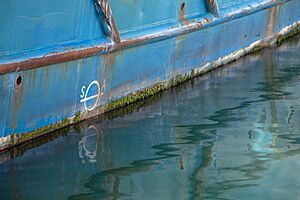Waterline facts for kids
The waterline is a special line on a ship's body, called the hull. It marks exactly where the hull touches the surface of the water when the ship is floating. Think of it as the "water level" on the side of a boat!
This term can also mean any line drawn on a ship's hull that is perfectly flat and parallel to the water's surface. These lines help ship designers understand and plan the shape of a ship.
The load line, also known as the Plimsoll line, is a very important waterline. It shows the highest point a ship can be safely loaded with cargo. This line changes slightly depending on the type of water (fresh or salt) and its temperature. It helps make sure the ship stays safe and floats well, keeping its buoyancy.
For ships that push through the water, like many large cargo ships, their top speed is partly decided by how long their waterline is. This is called the waterline length. On a sailing boat, the waterline length can actually change when the boat leans over, or "heels." This change can affect how fast the sailboat moves through the water.
Contents
Understanding Ship Waterlines
A ship's waterline is more than just a mark. It's a key part of how ships are designed. Naval architects use many "waterlines" on their plans. These lines help them draw the exact shape of the hull. They ensure the ship is stable and efficient in the water.
The Important Plimsoll Line
The Plimsoll line is a set of marks on a ship's side. It tells the captain and crew how much cargo they can safely load. This prevents ships from being overloaded. Overloading could make a ship unstable or even sink. The line helps protect the ship, its crew, and the environment. It's a safety rule followed by ships all over the world.
How Waterline Length Affects Speed
For many boats, especially larger ones, the length of the waterline is a big factor in how fast they can go. Longer waterlines generally allow for higher speeds. This is because a longer waterline helps the boat move more smoothly through the water. It creates less resistance. When a sailboat leans, its waterline length can increase. This can give it a temporary speed boost!
Waterlines in Aircraft Design
In aircraft design, the word "waterline" has a different meaning. Here, it refers to a horizontal reference line. Engineers use these lines to check the alignment and shape of an airplane's body, called the fuselage.
The main reference line is called "waterline 0" (WL 0). All other waterline measurements are taken from this base. For example, if a part is 10 inches above WL 0, its waterline number is WL 10. These measurements help ensure all parts of the aircraft are built and placed correctly. This is very important for safety and performance.
See also
 In Spanish: Línea de flotación para niños
In Spanish: Línea de flotación para niños
- Waterline length



